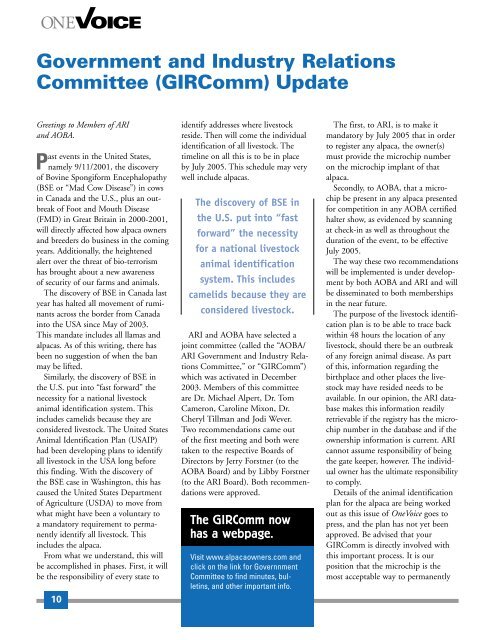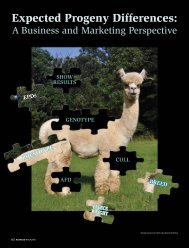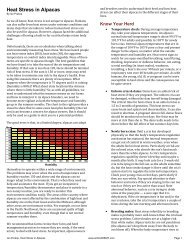IN THIS ISSUE: pgs 6-14 pgs 24-37 pgs 38-42 SEE YOU AT: - ariLIST
IN THIS ISSUE: pgs 6-14 pgs 24-37 pgs 38-42 SEE YOU AT: - ariLIST
IN THIS ISSUE: pgs 6-14 pgs 24-37 pgs 38-42 SEE YOU AT: - ariLIST
Create successful ePaper yourself
Turn your PDF publications into a flip-book with our unique Google optimized e-Paper software.
Government and Industry Relations<br />
Committee (GIRComm) Update<br />
Greetings to Members of ARI<br />
and AOBA.<br />
Past events in the United States,<br />
namely 9/11/2001, the discovery<br />
of Bovine Spongiform Encephalopathy<br />
(BSE or “Mad Cow Disease”) in cows<br />
in Canada and the U.S., plus an outbreak<br />
of Foot and Mouth Disease<br />
(FMD) in Great Britain in 2000-2001,<br />
will directly affected how alpaca owners<br />
and breeders do business in the coming<br />
years. Additionally, the heightened<br />
alert over the threat of bio-terrorism<br />
has brought about a new awareness<br />
of security of our farms and animals.<br />
The discovery of BSE in Canada last<br />
year has halted all movement of ruminants<br />
across the border from Canada<br />
into the USA since May of 2003.<br />
This mandate includes all llamas and<br />
alpacas. As of this writing, there has<br />
been no suggestion of when the ban<br />
may be lifted.<br />
Similarly, the discovery of BSE in<br />
the U.S. put into “fast forward” the<br />
necessity for a national livestock<br />
animal identification system. This<br />
includes camelids because they are<br />
considered livestock. The United States<br />
Animal Identification Plan (USAIP)<br />
had been developing plans to identify<br />
all livestock in the USA long before<br />
this finding. With the discovery of<br />
the BSE case in Washington, this has<br />
caused the United States Department<br />
of Agriculture (USDA) to move from<br />
what might have been a voluntary to<br />
a mandatory requirement to permanently<br />
identify all livestock. This<br />
includes the alpaca.<br />
From what we understand, this will<br />
be accomplished in phases. First, it will<br />
be the responsibility of every state to<br />
10<br />
identify addresses where livestock<br />
reside. Then will come the individual<br />
identification of all livestock. The<br />
timeline on all this is to be in place<br />
by July 2005. This schedule may very<br />
well include alpacas.<br />
The discovery of BSE in<br />
the U.S. put into “fast<br />
forward” the necessity<br />
for a national livestock<br />
animal identification<br />
system. This includes<br />
camelids because they are<br />
considered livestock.<br />
ARI and AOBA have selected a<br />
joint committee (called the “AOBA/<br />
ARI Government and Industry Relations<br />
Committee,” or “GIRComm”)<br />
which was activated in December<br />
2003. Members of this committee<br />
are Dr. Michael Alpert, Dr. Tom<br />
Cameron, Caroline Mixon, Dr.<br />
Cheryl Tillman and Jodi Wever.<br />
Two recommendations came out<br />
of the first meeting and both were<br />
taken to the respective Boards of<br />
Directors by Jerry Forstner (to the<br />
AOBA Board) and by Libby Forstner<br />
(to the ARI Board). Both recommendations<br />
were approved.<br />
The GIRComm now<br />
has a webpage.<br />
Visit www.alpacaowners.com and<br />
click on the link for Governnment<br />
Committee to find minutes, bulletins,<br />
and other important info.<br />
The first, to ARI, is to make it<br />
mandatory by July 2005 that in order<br />
to register any alpaca, the owner(s)<br />
must provide the microchip number<br />
on the microchip implant of that<br />
alpaca.<br />
Secondly, to AOBA, that a microchip<br />
be present in any alpaca presented<br />
for competition in any AOBA certified<br />
halter show, as evidenced by scanning<br />
at check-in as well as throughout the<br />
duration of the event, to be effective<br />
July 2005.<br />
The way these two recommendations<br />
will be implemented is under development<br />
by both AOBA and ARI and will<br />
be disseminated to both memberships<br />
in the near future.<br />
The purpose of the livestock identification<br />
plan is to be able to trace back<br />
within 48 hours the location of any<br />
livestock, should there be an outbreak<br />
of any foreign animal disease. As part<br />
of this, information regarding the<br />
birthplace and other places the livestock<br />
may have resided needs to be<br />
available. In our opinion, the ARI database<br />
makes this information readily<br />
retrievable if the registry has the microchip<br />
number in the database and if the<br />
ownership information is current. ARI<br />
cannot assume responsibility of being<br />
the gate keeper, however. The individual<br />
owner has the ultimate responsibility<br />
to comply.<br />
Details of the animal identification<br />
plan for the alpaca are being worked<br />
out as this issue of OneVoice goes to<br />
press, and the plan has not yet been<br />
approved. Be advised that your<br />
GIRComm is directly involved with<br />
this important process. It is our<br />
position that the microchip is the<br />
most acceptable way to permanently





